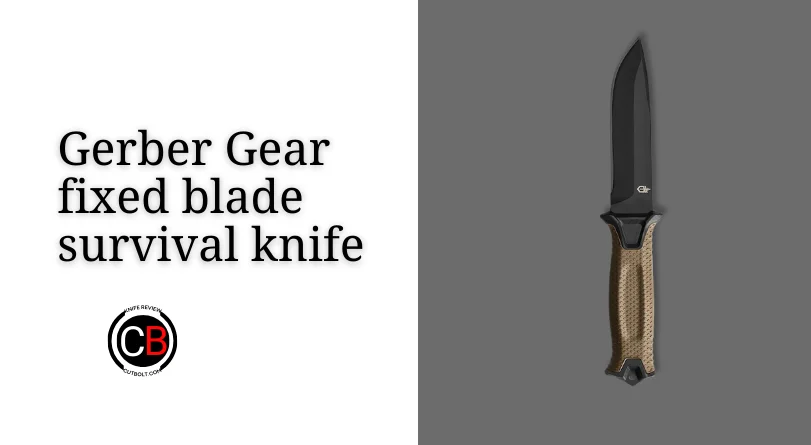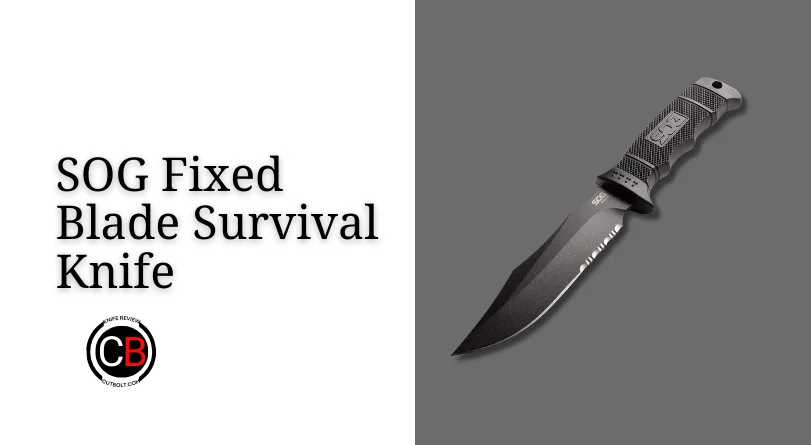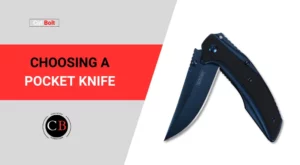There is no one ultimate survival knife that surpasses all others. A good survival knife is, above all, a knife that suits your needs and personal preferences. But then, how to choose a survival knife?
Before we start the process of choosing a survival knife, let us know what a survival knife is:
- What is a survival knife?
- Types of survival knives available
- What material is good for survival knife blades?
- Different blade shapes of survival knives
- How long should the blade of a survival knife be?
- What type of grind do survival knives usually have?
- What type of sheath is recommended for a survival knife?
- What type of handle is good for survival knives?
- What would the ultimate survival knife look like?
- Is there any weak point of a survival knife?
- How do you sharpen a survival knife when you're on the go?
- How much should you spend on a survival knife?
- What is my favorite survival knife?
- Conclusion: Choosing a survival knife
What is a survival knife?
A survival knife is a specialized knife characterized by a durable fixed blade, often with full tang construction, that can withstand rigorous use. The design focuses on practicality and utility, enabling the user to perform tasks such as cutting, chopping, carving, and even self-defense, when necessary.
Survival knives are an essential piece of equipment for outdoor enthusiasts, adventurers, and survivalists who need to ensure their readiness in challenging environments.

Types of survival knives available
There are different types of survival knives, each with their advantages and disadvantages. Here are some of the most common:
- Fixed blade knife: Fixed blade survival knives are renowned for their strength and reliability. With their superior strength, they offer better cutting capacity and greater versatility for survival tasks. The blade is attached to the handle.
- Folding knife: Compact and easy to carry, folding knives feature a folding blade that stores inside the handle, making them more secure when not in use. Although often smaller than fixed-blade knives, some folding models offer sufficient strength and versatility for survival activities.
- “Serrated” blade knife: Some survival knives combine a smooth blade with serrated parts. The notched part allows for more efficient cutting of materials such as ropes, branches or fabrics. These knives provide additional versatility for survival tasks requiring fast, efficient cutting.
- Full tang blade knife: The term “full tang” refers to a blade that extends the entire length of the knife handle. Full-tang blade knives are known for their increased strength and durability, making them suitable for rigorous survival tasks. This design effectively transfers force along the entire length of the knife, making it less likely to break or warp. It is the survival knife par excellence, almost “unbreakable”.
- Rat-tail tang: Like the full tang, the blade extends into the handle but only part of the length and then tapers to become narrower. This rod is then attached or welded to the handle of the knife. These knives are more resistant than fixed-blade knives but less than “full tang”.
What material is good for survival knife blades?
The type of steel used to make the blade is one of the first selection criteria. Though, the material used does not directly determine the survival knife you need, but it does help you determine the category of knife you will choose. There are three main categories of steel for knives: stainless steel, carbon steel and tool steel.
These different steels are obtained applying different heat treatments and therefore have very diverse characteristics. I will not give you an exhaustive list of the properties of each type of steel. But you will discover the essentials to identify the blade that meets your needs.
Carbon steel blade
As its name suggests, carbon steel has high carbon content, but it has low corrosion resistance due to its low chromium content. Cut fruit and forget to wash it properly, you may see rust appear within a few hours or days later.
Salt water or salt are also great enemies of a carbon steel blade, quickly causing it to rust. Carbon steel camping knife blades should have anti-corrosive coating to prevent the appearance of rust wherever possible.
Carbon steel survival knives have high resistance making it tough to crack. This allows you to cut hard objects more easily. Carbon steel survival knives are easy to sharpen (even if it gets rust while you are outdoor enjoying camping).
Stainless steel blade
Unlike carbon steel, stainless steel or corrosion-resistant steel has high chromium content, but a slightly lower carbon content. It has greater resistance to corrosion, which significantly increases its durability. Stainless steel survival knives are much more advantageous in a humid or salty environment. Generally, a stainless steel blade does not require very much maintenance.
However, you will not get the same resistance nor a blade as sharp as with carbon steel. In general, a stainless steel blade is less resistant to shock and is much more difficult to sharpen, even if certain stainless steels offer good performance.
Tool steel
Halfway between impact resistance and corrosion resistance, tool steel is characterized by a high content of both carbon and chromium, although not as high as the first two categories of steel. It brings together the best of both worlds. So a survival knife blade made of tool steel rusts much less quickly than one made of carbon steel. In addition, it is more resistant to shocks and easier to sharpen than a stainless steel blade. It is therefore a good alternative to the first two blades.

Different blade shapes of survival knives
What blade shape is good for a survival knife? The shape of the blade depends on its use.
Here are the most common forms:
- Clip point: Tapered tip, the top of the blade slopes downward while the tip rises upward. This shape is useful for precision work and for hunting.
- Tanto: Triangular point. This shape is ideal for survival or for a tactical knife due to increased penetration. Robust, it is also ideal for cutting hard materials.
- Spear point: The top of the blade is curved until it meets the point. This form is sturdy like the tanto but more versatile.
- Drop point: The top of the blade is curved to the tip but the curvature is much less pronounced than for a spear point blade. It is the simplest form and therefore certainly the most versatile.
Personally, I prefer knives with drop-point blades. This blade shape makes the knife very robust and allows the tip of the knife to be used for rougher work. The shape is ideal for gutting animals. I generally advise against a partially serrated edge due to the poor cutting and sharpenability, as well as the “back of the saw”, which you cannot hit (hatchet substitute).
How long should the blade of a survival knife be?
A knife with a blade length of 10 to 12 cm is completely sufficient. Blades larger than 12 cm are firstly impractical because they are more difficult to handle and secondly (like one-hand knives) they are generally prohibited by law. However, there are exceptions if using the knife is related to professional practice, customs, sport or other generally recognized purposes (e.g. hunting, fishing, camping or forest work). Before every flight, you should check what the regulations are in the country you are traveling to and of course, knives do not belong in hand luggage.
What type of grind do survival knives usually have?
Flat or convex grinds are common. I prefer the convex grind as it is more durable and particularly suitable for rougher work. One disadvantage is the difficulty of sharpening the knife under survival conditions (i.e. without sandpaper or stone). The flat grind is an advantage here.

What type of sheath is recommended for a survival knife?
Sheaths are necessary for several reasons. On the one hand, they protect the knife owner from injuries in the event of a fall, for example, and on the other hand, they significantly extend the life of the knife’s sharpness.
I have had good experiences with both plastic sheaths and leather sheaths. Leather sheaths require a little care every now and then, but are just as durable as plastic sheaths.
Some sheaths accommodate additional tools, such as a fire starter or whetstone. A lock generally makes sense.
What type of handle is good for survival knives?
If the type of knife and the material of the blade are not enough to help you make your choice, you can also pay attention to the type of material used for the handle:
- Wood: Aesthetic and warm, wood is a traditional material. Pleasant to use, it is however not the ideal material for “survival” type use since it requires regular maintenance and is more sensitive to humidity.
- G10 and Micarta: These composite materials are made by superimposing several layers of fiberglass or canvas soaked in epoxy resin. These types of knife handles are durable, resistant to moisture, chemicals and extreme temperatures. They provide excellent grip, even in wet or slippery conditions, making them popular as survival knives.
- Rubber: Rubber can also provide a very good grip depending on the texture provided. It is a stable material and perfectly suited to wet conditions. Rubber also absorbs shock and vibration. However, rubber is much less resistant to excessive heat, which can be seen as a real disadvantage.
For a survival knife handle, my first choice is either G10 or Micarta (details in the knife handle material section). Rubber is also preferable, but I would not go for a wooden handle for a survival knife.

What would the ultimate survival knife look like?
- robust, durable, stable
- fixed blade of about 10 cm
- drop point blade or normal blade
- convex or flat grind
- stainless, not too hard steel
- ergonomic handle and good handling
Is there any weak point of a survival knife?
One problem with a survival knife is that it has to meet many demands. In a survival situation, you will use it for both fine and rough work. The range of expectations lies between filleting knives and machetes.
I should tell you that an all-round knife is always somewhere in the middle and cannot fulfill all tasks 100%. On a planned outdoor tour, you can counteract this by carrying two knives with you: a sharp, fine knife for delicate tasks and a second, robust one for rough tasks. In an emergency, however, you will be glad to have a knife with you.
How do you sharpen a survival knife when you’re on the go?
At best, you have a small whetstone in your survival kit. If you have to use materials from nature, a simple – but unfortunately not always successful – method is to look for a suitable stone and grind it in a circular motion while adding water. For example, pebbles (quartz) or marble are somewhat suitable.
Sometimes you can also find ceramic objects in nature (e.g. dishes, or tiles) whose unglazed surfaces can be used to achieve usable results. In addition to the material used, consistently maintaining the correct angle (around 25° to 35°) is crucial.
How much should you spend on a survival knife?
For a usable survival knife, I would estimate around 50 dollars (the lower end). In my experience, cheaper knives often wear out quickly, leave a lot to be desired in terms of workmanship and are very strenuous or even painful during longer work. Of course, you can also spend significantly more money on a knife.
What is my favorite survival knife?
I have been using a Morakniv Garberg carbon steel full-tang fixed blade knife for many years. It is made of hardened Sandvik 12C27 stainless steel. The blade length is 4.3 inches (including handle it is 9 inches) and 3.2mm thick making it ideal for survival activities.
I chose the knife for several reasons: very good price-performance ratio (below $80), robust appearance and grip and a high-quality leather sheath (you can get the survival sheath also). It comes with a fire starter and diamond sharpening stone are fitted.
Conclusion: Choosing a survival knife
So, how to choose a survival knife? Choosing the right survival knife is a critical step in preparing for any outdoor adventure or survival situation. By prioritizing a knife with a sturdy fixed blade, full tang, ergonomic handle, and made of high-quality steel, you ensure a dependable partner in the wilderness.
Remember that the best survival knife is the one that suits your specific needs and feels right in your hand. So, take your time to research, hold, and if possible, test different knives until you find the perfect match. A well-chosen survival knife will not only boost your confidence in the great outdoors but might one day be the tool that saves your life.

